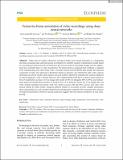Files in this item
Frame-by-frame annotation of video recordings using deep neural networks
Item metadata
| dc.contributor.author | Conway, Alexander | |
| dc.contributor.author | Durbach, Ian Noel | |
| dc.contributor.author | McInnes, Alistair | |
| dc.contributor.author | Harris, Rob | |
| dc.date.accessioned | 2021-03-03T12:30:01Z | |
| dc.date.available | 2021-03-03T12:30:01Z | |
| dc.date.issued | 2021-03 | |
| dc.identifier | 272576839 | |
| dc.identifier | 6a803ac2-7c51-41e0-9b90-f1051adeb150 | |
| dc.identifier | 85103399895 | |
| dc.identifier | 000636318200004 | |
| dc.identifier.citation | Conway , A , Durbach , I N , McInnes , A & Harris , R 2021 , ' Frame-by-frame annotation of video recordings using deep neural networks ' , Ecosphere , vol. 12 , no. 3 , e03384 . https://doi.org/10.1002/ecs2.3384 | en |
| dc.identifier.issn | 2150-8925 | |
| dc.identifier.other | ORCID: /0000-0003-0769-2153/work/90112771 | |
| dc.identifier.uri | https://hdl.handle.net/10023/21545 | |
| dc.description | Funding: Scottish Government (Grant Number(s): Marine Mammal Scientific Support Research Program); Homebrew Films; National Research Foundation of South Africa (Grant Number(s): 105782, 90782). | en |
| dc.description.abstract | Video data are widely collected in ecological studies, but manual annotation is a challenging and time‐consuming task, and has become a bottleneck for scientific research. Classification models based on convolutional neural networks (CNNs) have proved successful in annotating images, but few applications have extended these to video classification. We demonstrate an approach that combines a standard CNN summarizing each video frame with a recurrent neural network (RNN) that models the temporal component of video. The approach is illustrated using two datasets: one collected by static video cameras detecting seal activity inside coastal salmon nets and another collected by animal‐borne cameras deployed on African penguins, used to classify behavior. The combined RNN‐CNN led to a relative improvement in test set classification accuracy over an image‐only model of 25% for penguins (80% to 85%), and substantially improved classification precision or recall for four of six behavior classes (12–17%). Image‐only and video models classified seal activity with very similar accuracy (88 and 89%), and no seal visits were missed entirely by either model. Temporal patterns related to movement provide valuable information about animal behavior, and classifiers benefit from including these explicitly. We recommend the inclusion of temporal information whenever manual inspection suggests that movement is predictive of class membership. | |
| dc.format.extent | 11 | |
| dc.format.extent | 3523474 | |
| dc.language.iso | eng | |
| dc.relation.ispartof | Ecosphere | en |
| dc.subject | Animal-borne video | en |
| dc.subject | Automated detection | en |
| dc.subject | Deep learning | en |
| dc.subject | Image classification | en |
| dc.subject | Neural networks | en |
| dc.subject | Video classification | en |
| dc.subject | GC Oceanography | en |
| dc.subject | QA75 Electronic computers. Computer science | en |
| dc.subject | QH301 Biology | en |
| dc.subject | DAS | en |
| dc.subject.lcc | GC | en |
| dc.subject.lcc | QA75 | en |
| dc.subject.lcc | QH301 | en |
| dc.title | Frame-by-frame annotation of video recordings using deep neural networks | en |
| dc.type | Journal article | en |
| dc.contributor.institution | University of St Andrews. Sea Mammal Research Unit | en |
| dc.contributor.institution | University of St Andrews. Scottish Oceans Institute | en |
| dc.contributor.institution | University of St Andrews. School of Biology | en |
| dc.contributor.institution | University of St Andrews. School of Mathematics and Statistics | en |
| dc.contributor.institution | University of St Andrews. Centre for Research into Ecological & Environmental Modelling | en |
| dc.identifier.doi | 10.1002/ecs2.3384 | |
| dc.description.status | Peer reviewed | en |
| dc.identifier.url | https://www.biorxiv.org/content/10.1101/2020.06.29.177261v1.full | en |
This item appears in the following Collection(s)
Items in the St Andrews Research Repository are protected by copyright, with all rights reserved, unless otherwise indicated.

